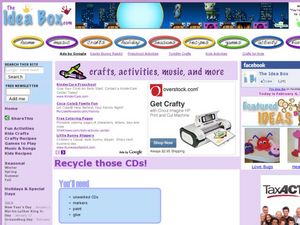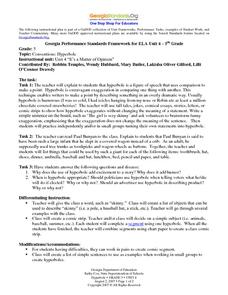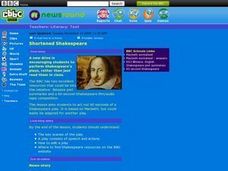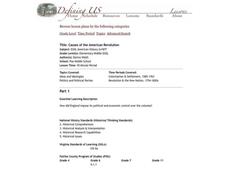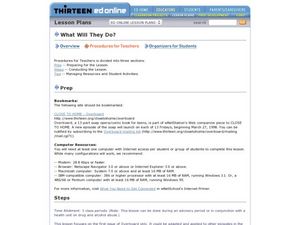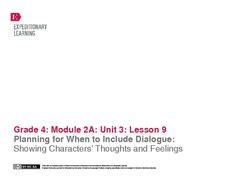Curated OER
Recycle Those CDs!
Students recycle unwanted CDs for art projects. In this art lesson, students can glue comic strips to the CD's creating Christmas ornaments or coasters with markers or paint.
Curated OER
Conventions: Hyperbole
Fifth graders discuss hyperbole. In this language arts instructional activity, 5th graders understand that hyperbole enables writers to make a point by describing something in an overly dramatic way. Students create a list of objects...
Curated OER
Learning the Component and Information Found in the Newspaper
Fifth graders work in a group to identify and reference the index, front page, metro page, state and local pages, as well as the sports, comics and classifieds in the newspaper 90% of the time during the game of "Identifying and...
Curated OER
Declaration of Independence and the Constitution
Fifth graders read a rewritten version of the Declaration of Independence, create a set of pictures illustrating the Preamble of the Constitution and create a version of the Declaration of Independence in the form of a song, a poem,...
Curated OER
Shortened Shakespeare
Students discover the two main ingredients of a play: speech and actions. They then listen to a shortened version of "Macbeth" and write down one sentence to describe what is happening in each of the comic-strip cells.
Curated OER
Landmarks in Paris
Third graders create a map of France. They use computers to view an "in flight" movie about Paris. They research Paris using books and the internet. Students practice using the program "Comic Life." They import illustrations for each of...
Curated OER
The Phases of the Moon
Students observe the questions, "Why do we say there is a man on the moon?, What do you think of when you hear "the moon is made of cheese"?, What is meant, to you, by the expression "Once in a blue moon"? and a comic of Snoopy typing,...
Curated OER
Causes of the American Revolution
Learners answer the question of: How did England impose its political and economic control over the colonies? They create a comic strip depicting the event of the Boston Massacre. Students complete a Wordstoming activity to anticipate...
Curated OER
Interative History Notebook Mini-lesson
High schoolers respond to Holocaust literature. In this interactive history lesson, students select quotes from chapter 1 of Elie Wiesel's Night and reflect on their meaning as they record their thoughts on poetic, prose, comic. or...
Curated OER
Dazzling Dialogue
Young scholars practice the proper use of Capital letters in quotes and how to use quotation marks. In this dazzling dialogue lesson, students write a draft of a script using dialogue and capitalization. Young scholars...
Curated OER
Pilkey Author Study
Third graders read and hear stories by the author, Dav Pilkey and research the list of books written by this author. They become illustrators to the novel "Captain Underpants: An Epic Novel," then they create a timeline of their lives...
Curated OER
CLOSE TO HOME - Overboard
Students read a comic about a teen drug overdose that leads to death. In this drug awareness lesson, students role play characters in the story that react to the death of their friend due to drug use in an online forum. Students evaluate...
Curated OER
My First Day of School
In this Junie B. Jones activity activity, students think about their first day of school and create a comic strip using the 8 boxes to depict their day.
Council for Economic Education
Jokes, Quotations, and Cartoons in Economics
Humor offers a great tool teach the basics of economics to scholars via video clips, satire, and political cartoons. Individuals create their own economic humor to present to the class—with the assistance of Daryl Cagel's online...
We are Teachers
Read Like a Detective
Encourage your young readers to become true detectives in their next literary adventure! Here you'll find an attractive display that will prompt your learners to constantly be looking for clues, asking questions, making cases...
Australian Centre For the Moving Image
Dreamworks Animation Character Design
Dive into animation creation using Dreamworks® animated films. Compare and contrast characters, wonder and ponder why the plot is so important, and think of background and themes as your creativity unrolls onto paper.
EngageNY
Planning for When to Include Dialogue: Showing Characters’ Thoughts and Feelings
Young writers examine dialogue conventions, including indentation, quotation marks, and expressing thoughts and feelings through a fictional text. By noticing where and when authors use dialogue, they decide how to incorporate dialogue...
Virginia Department of Education
Weathering of Limestone
We all know limestone weathers, but what affects the rate of weathering? Young scientists investigate the physical and chemical weathering of limestone (chalk) through experimentation. First, they conduct trials with different-size...
Virginia Department of Education
Laboratory Safety and Skills
Avoiding lab safety rules will not give you super powers. The lesson opens with a demonstration of not following safety rules. Then, young chemists practice their lab safety while finding the mass of each item in a mixture and trying to...
Odell Education
Plant and Animal Cells
Incorporate multiple facets of the cell into your next high school lab! Through an introduction to cell organelles, class members observe each cell type and draw visuals to further demonstrate understanding of cellular processes in both...
Woo! Jr. Kids
Charlie Brown Christmas Coloring Page with Snoopy
Pay homage to the classic movie, A Charlie Brown Christmas, and encourage holiday cheer with a coloring page featuring Charlie standing near the iconic drooping Christmas tree and Snoopy on top of his decorated doghouse.
S2tem Centers SC
Seasons
Winter, spring, summer, and fall—take the learning of the seasons beyond the elementary level to the middle school classroom. Curious learners begin by watching videos about the seasons and the rotation of planet Earth. Then,...
Curriculum Corner
Fiction Graphic Organizers
Get an in-depth look into a narrative text with a three-page learning exercise that examines a story's character—actions, sayings, thoughts, and appearance—setting, and challenges scholars to write a brief summary about what they've...
Curriculum Corner
Fiction Graphic Organizers
Analyze a fictional text with a four-page packet that explores a story's main character and moral, challenges scholars to ask and answer questions about the text, and to create a story map.
Other popular searches
- Comic Strips Powerpoint
- Onomatopoeia Using Comics
- Comic Protagonist
- Making Comic Strips
- Comic Strip Sequence
- Comic Strip Writing
- Comic Relief
- American Comics
- Comic Stips
- Editorial Cartoons & Comics
- Comic Strip Template
- Writing Comics


